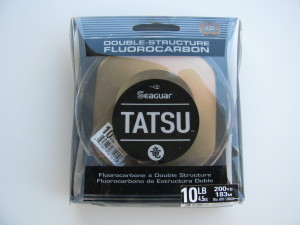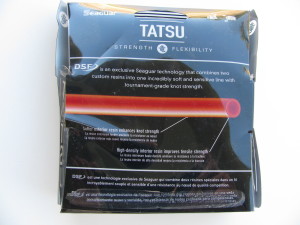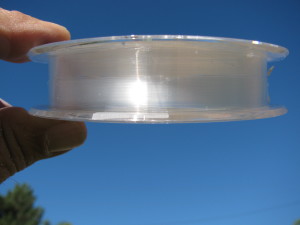In our last review we eluded to the fact that we were using a new line, at least to us, on the Energy PT. This is the subject of our review. Seaguar’s Tatsu Fluorocarbon line. Granted, we don’t use fluoro’s for the majority of our testing as the cost can be prohibitive but that doesn’t mean we exclude them entirely.
On the contrary, we’ve used several of them from various manufacturers. All touting the strengths of fluorocarbon as opposed to monofilament.
Why fluorocarbon?
We’ve all heard of the advantages of using this type of line. Fluorocarbon is supposed to be more abrasion resistant, have less stretch, sink faster and deeper, have more innate sensitivity and perhaps most critical, has almost the same refractive index as water which makes it virtually disappear underwater compared to other lines.
Okay, so what are the facts behind the claims when it comes to fluorocarbon lines in general? Let’s take a look before we get into the specifics of Tatsu.
Let’s take this claim by claim to see if there there are some chinks in the armor so that you can determine if this tool is one that you want to invest in.
Fluorocarbon is more abrasion resistant. Okay, we’ll give it that one. Fluoro is certainly more dense than mono or co-polymer which translates to better resistance to abrasion.
Fluorocarbon’s Achilles heel
Fluoro has less stretch than mono or co-polymer. All we’re going to do here is quote one of the legends of our sport, Bill Dance. “My good friend Eric Naig at Berkley says that all nylon monofilament contains 18 to 35 percent stretch, while most fluorocarbon contains 28 to 38 percent. And stretch in braided line is in the 2 to 7 percent range. The difference is that nylon has a stretch recovery, or rubber band effect. Fluorocarbon may elongate, but differently, Actually the density of the line is what makes it more sensitive.”
So the stretch claim doesn’t seem to be as accurate as one is led to believe by the advertising.
Fluoro sinks faster and deeper. Here again, the fact that fluoro is more dense than mono or co-polymer definitely supports this claim.
It’s more sensitive. Yes it is. There is no doubt about this one although it is not magic. The density and the material used are more sensitive which translates vibrations more efficiently.
Fluoro has almost the same refractive index as water. It actually does, no doubt about it. So what does all this mean and how does it apply to our review?
Is Tatsu different?
Seaguar has been making fluorocarbon for a very long time. They are one of the early pioneers of manufacturing this type of line. As a matter of fact, they produce several grades of fluoro with Tatsu being one of the most advanced.
Tatsu is made using a proprietary extrusion process that employs two custom, 100% fluorocarbon resins which results in their double structure fluorocarbon line. There is a softer exterior resin that provides knot strength and flexibility while the harder interior resin improves tensile strength.
This is important because there are lines out there that say they are fluorocarbon but are not 100% fluoro. This can and will make a difference in the handling characteristics. Simply put, they will not give you all of the advantages of 100% fluorocarbon.
We chose the 10 pound test for our testing and have used it for several months now throwing everything that we normally would on this test pound including crankbaits, weighted and unweighted soft plastics, small jigs, swim baits, small top-water plugs and a host of other lures.
How does Tatsu perform?
Our first cast with the Tatsu was eye opening in terms of this is one of the best handling fluoros we have ever used. It is soft, supple, smooth and feels downright good under your thumb. There is very little memory in the line which was a pleasant surprise. Furthermore, casting distance isn’t compromised at all with this line. It sails off the spool without a hitch.
Once you begin your retrieve, the Seaguar Tatsu does an excellent job of transmitting every little vibration to your hands. You feel things that you simply cannot feel with some other lines. It also increases the sensation from your bait when in open water.
The very first strike we got when fishing the Tatsu was on a shakey head jig we were using on the outside of weed edges. That fish picked up the bait and tried to run back into the salad quick, fast and in a hurry!
Fortunately, we felt him as soon as he picked up the bait, set the hook and landed him without having to horse him out of the slop. The Tatsu is that sensitive. You will feel bites sooner with this line than most others.
For that matter, every strike is exaggerated when using this line due to its sensitivity. Not only is this fun, you convert more bites because you feel the slightest tick on your line.
We haven’t experienced any problems with this line to this point. The Tatsu has exceeded our expectations in all areas but there is a caveat to this.
Are there any tips for taking care of fluoro?
We were aware on fluorocarbons limitations prior to testing this line so we do a few things that have become a part of our regimen when using fluoros. We check the last ten feet or so of our line every several casts when using it around structure. We also retie every few fish snipping about a yard of line off the end when we do. We don’t use any line conditioner on fluoro as this can adversely affect the line.
Another thing to keep in mind is that fluoro’s in general really shine when used on “feel” techniques and in very clear water. With the cost of this line, you might want to limit its use somewhat and opt for less expensive alternatives when conditions allow.
Or you can do what we have done. Tatsu comes in 200 yard spools. We don’t spool an entire reel with it. We use a co-polymer as a backing which we attach about 65 yards of Tatsu to. This not only helps keep the cost down but it also gives us plenty of line for the vast majority of applications and used this way, a single spool can fill three reels.
If you’ve never tied two lines together like this, there is a very helpful knot guide on Seaguar’s website that will show you how to do it. It takes some practice but it’s well worth it in the long run.
Another thing to keep in mind is that you can upsize your line for most applications when using fluoro due to its relative invisibility in the water. We don’t recommend going crazy to the point that you over power a bait but use the upper end of the test pound spectrum if at all possible.
Wrapping it up
Seaguar Tatsu Fluorocarbon line has earned a place on some of our rods full time. The combination of handling, sensitivity and abrasion resistance are hard not to take advantage of once you’ve gotten used to them.
Yes it’s a little pricey but until you’ve tried it, you can’t appreciate what you’re missing.
| Seaguar Tatsu Fluorocarbon Line | |
|---|---|
| Overall Rating | |
| An awesome line for feel baits | |
See ya’ on the water …


